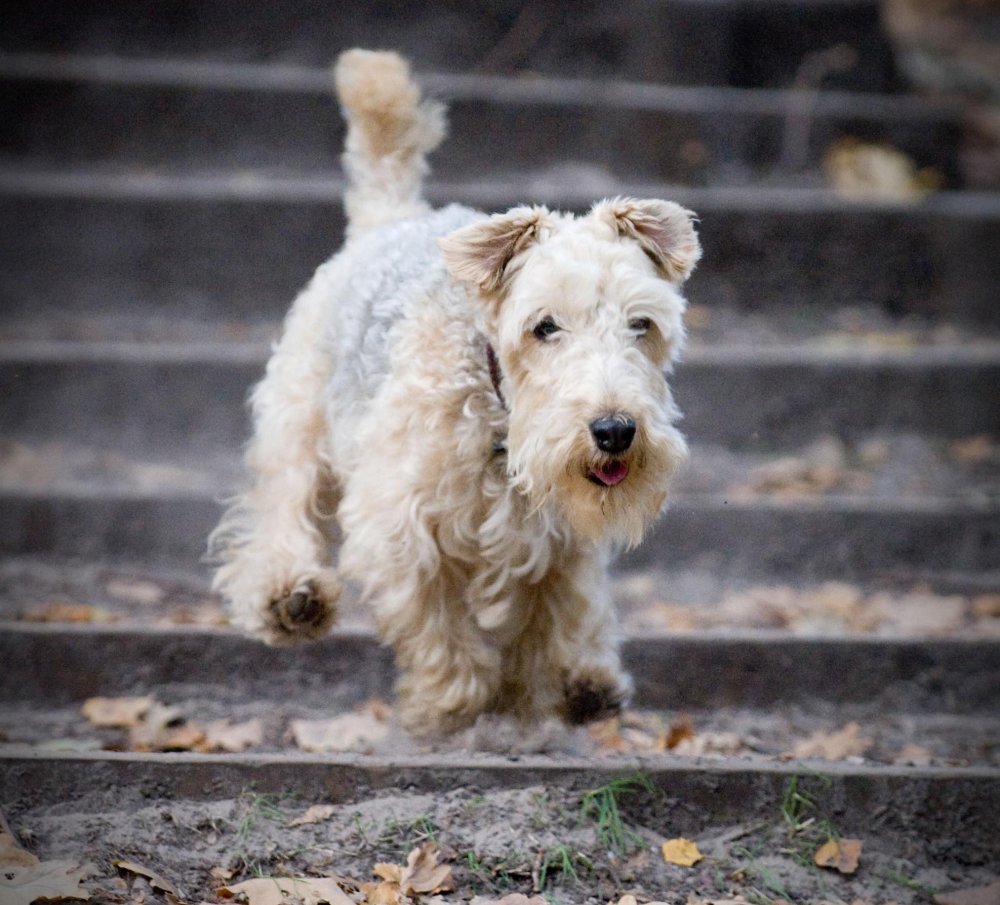- Breed Category: Terrier
- Country of Origin: United Kingdom
- Average Height: 36-38 cm (14-15 in)
- Average Weight: 7-8 kg (15-17 lbs)
- Average Life Span: 12-15 years
- Grooming Requirements: Regular brushing and trimming
- Exercise Requirements: High; needs daily exercise
- Coat Type: Dense, wiry
- Coat Color Variations: Black, blue, liver, red
- Shedding Level: Low
- Ear Type: V-shaped, folded
- Tail Type: Medium, carried high
- Temperament: Bold, friendly, confident
- Intelligence Level: High
- Barking Tendency: Moderate
- Compatibility with Children: Good with older children
- Compatibility with Other Pets: May chase smaller animals
- Training Ease: Moderate; requires consistency
- Common Health Issues: Eye problems, hip dysplasia
- Dietary Needs: High-quality dog food
- Energy Level: High
- Drooling Tendency: Low
- Sensitivity to Weather: Sensitive to extreme heat
- Overall Maintenance Level: Moderate
- Original Purpose: Hunting and vermin control
- Year of Recognition by Kennel Clubs: 1921
- Apartment Friendly: Yes, with sufficient exercise
- Best Suited For: Active families, experienced owners
- Cost of Ownership: Moderate
- Unique Traits: Distinctive beard and eyebrows
- Popularity Rank: Moderately popular
Imagine a dog that’s as spirited as it is charming, with a history as rich as its personality. Meet the Lakeland Terrier. This breed, hailing from the rugged landscapes of England’s Lake District, is known for its tenacity and intelligence. Originally bred to hunt foxes, these terriers are small but mighty, with a fearless nature that belies their size. Their wiry coat and keen expression make them stand out in any crowd.
In this article, we’ll dive into what makes the Lakeland Terrier unique. From their fascinating history to their distinct characteristics and care needs, you’ll discover why this breed might just be the perfect addition to your family.
History and Origin

Early Development of the Breed
The Lakeland Terrier’s roots trace back to the 18th century in England’s Lake District. This rugged terrain demanded a dog with both stamina and courage. Farmers needed a breed that could tackle the challenging landscape and keep up with the demands of rural life. The Lakeland Terrier was developed by crossing various terrier breeds, including the Bedlington and Border Terriers, to create a dog that was not only tenacious but also agile and resilient.
Role in Hunting and Farming in the UK
These terriers were primarily bred for hunting foxes that threatened livestock. Their small size allowed them to navigate rocky terrains and burrows with ease. On farms, they were invaluable for controlling vermin, making them a farmer’s best friend. Their keen sense of smell and determination made them exceptional hunters, capable of working tirelessly in harsh conditions.
Key Historical Figures
One notable figure in the development of the Lakeland Terrier was the Reverend John Russell, who was instrumental in refining the breed’s characteristics. His dedication to breeding a dog that was both functional and spirited helped shape the Lakeland Terrier into the breed we know today.
Physical Characteristics

Appearance
The Lakeland Terrier is a compact and sturdy little dog, typically standing about 33 to 38 centimetres tall at the shoulder. Despite their small stature, they have a robust build that speaks to their working heritage. Their coat is a standout feature—wiry and dense, it comes in a variety of colours including black, blue, liver, red, and wheaten. Some even sport a charming mix of these shades. Distinctive markings, like a saddle pattern on their back, add to their unique look.
Unique Physical Traits
One of the most striking traits of the Lakeland Terrier is their expressive face, often highlighted by a bushy beard and eyebrows that give them a wise, almost mischievous appearance. Their compact build is not just for show; it’s a testament to their agility and strength, allowing them to navigate tough terrains with ease. This breed is truly a blend of form and function, designed for both beauty and purpose.
Temperament and Behaviour

Typical Personality Traits
The Lakeland Terrier is a bundle of energy and intelligence. These dogs are known for their confidence, often strutting around with a sense of purpose. They’re quick learners, which makes training a breeze, but their independent streak can sometimes lead to a bit of mischief. With a high energy level, they thrive on activity and love having a job to do, whether it’s playing fetch or going for a long walk.
Suitability as a Family Pet and Working Dog
As a family pet, the Lakeland Terrier is a fantastic choice. Their playful nature and loyalty make them great companions. They’re also excellent working dogs, thanks to their history of hunting and farming. Their versatility means they can adapt to various roles, from being a loving family member to a diligent worker.
Interaction with Children and Other Animals
Lakeland Terriers generally get along well with children, especially if they’re raised together. Their playful and gentle nature makes them a hit with kids. However, early socialisation is key to ensuring they interact well with other animals. While they can be a bit territorial, proper training can help them coexist peacefully with other pets.
Training and Exercise Needs

Importance of Early Training and Socialisation
Getting a head start on training and socialisation is crucial for Lakeland Terriers. These little dynamos are smart and curious, so introducing them to different environments, people, and other animals early on helps shape a well-rounded dog. It’s all about setting the stage for a confident and sociable companion.
Recommended Training Techniques
When it comes to training, positive reinforcement is the way to go. Lakeland Terriers respond well to treats, praise, and play. Keep sessions short and fun to hold their attention. Consistency is key, and a bit of patience goes a long way, especially given their independent streak.
Daily Exercise Requirements and Activities They Enjoy
These terriers are bundles of energy, so daily exercise is a must. Think long walks, playtime in the yard, or even agility training. They love activities that challenge their minds and bodies. A bored Lakeland Terrier can become mischievous, so keeping them active is essential for a happy pup.
Health and Lifespan
Common Health Issues
Like any breed, Lakeland Terriers have their share of health concerns. They can be prone to eye issues such as lens luxation and cataracts. Skin allergies are also something to watch out for, given their dense, wiry coat. Regular vet check-ups can help catch these issues early.
Average Lifespan and Tips for Keeping Them Healthy
On average, Lakeland Terriers live between 12 to 15 years. To keep them healthy, a balanced diet and regular exercise are key. These terriers thrive on activity, so keeping them engaged physically and mentally is crucial. Regular grooming helps maintain their coat and skin health, reducing the risk of allergies.
Preventative Care Recommendations
- Regular vet visits for vaccinations and health screenings.
- Consistent grooming to prevent skin issues.
- Dental care, including brushing their teeth and providing dental chews.
- Maintaining a healthy weight through diet and exercise.
By staying proactive with their care, you can ensure your Lakeland Terrier enjoys a long, healthy life.
Grooming and Maintenance

Coat Care and Grooming Routines
The Lakeland Terrier’s wiry coat is one of its standout features, but it does require regular attention. A good brushing once or twice a week helps keep their coat looking its best and prevents matting. Using a slicker brush or a comb designed for wiry coats can make the task easier. Regular grooming not only keeps them looking sharp but also helps distribute natural oils, keeping their skin healthy.
Shedding and Seasonal Grooming Tips
While Lakeland Terriers are considered low shedders, they do experience some seasonal shedding. During these times, more frequent brushing can help manage loose hair. Hand-stripping, a technique where dead hair is plucked out, is recommended a few times a year to maintain the coat’s texture and colour. This might sound daunting, but with practice, it becomes a straightforward part of their grooming routine. If you’re unsure, a professional groomer can help keep your terrier looking its best.
Diet and Nutrition
Nutritional Needs for Optimal Health
Feeding your Lakeland Terrier the right diet is crucial for their health and vitality. These energetic dogs need a balanced diet rich in proteins, healthy fats, and essential vitamins. High-quality dog food, whether commercial or homemade, should be the foundation of their diet. Look for options that list meat as the first ingredient, ensuring they get the protein they need to support their active lifestyle.
Foods to Include and Avoid
Include lean meats, fish, and vegetables in their meals to provide a variety of nutrients. Omega-3 fatty acids, found in fish oil, can help maintain their skin and coat health. Avoid foods high in fillers, artificial preservatives, and excessive grains, as these can lead to allergies and digestive issues. Chocolate, onions, and grapes are toxic to dogs and should be kept out of reach.
Feeding Schedules and Portion Recommendations
Establishing a consistent feeding schedule helps maintain their energy levels and prevents overeating. Typically, two meals a day—morning and evening—work well for adult Lakeland Terriers. Puppies may require more frequent meals. Portion sizes depend on their age, weight, and activity level, so consult your vet for tailored advice. Always provide fresh water to keep them hydrated.
Fun Facts and Trivia
Interesting Tidbits About the Breed
Did you know that Lakeland Terriers are one of the oldest working terrier breeds? Their lineage dates back to the 18th century, making them a breed with a rich history. Despite their small size, these dogs have a big personality and are known for their fearless nature. They were originally bred to hunt foxes, which explains their tenacity and courage.
Another fun fact is that Lakeland Terriers are known for their unique coat colours. While many terriers have a standard colour, Lakelands can come in a variety of shades, including blue, black, liver, and red. This diversity in appearance adds to their charm and makes each one unique.
Famous Lakeland Terriers in Media or History
In the world of show dogs, Lakeland Terriers have made quite a name for themselves. One of the most famous Lakeland Terriers is “Champion Stingray of Derryabah,” who won Best in Show at the prestigious Crufts dog show in 1963. This win helped put the breed on the map and showcased their exceptional qualities.
In popular culture, Lakeland Terriers have appeared in various films and TV shows, often cast for their distinctive looks and lively personality. Their expressive faces and energetic nature make them a favourite choice for roles that require a bit of canine charisma.
Final Thoughts

The Lakeland Terrier is a spirited and versatile companion. With its rich history and distinctive traits, this breed offers both charm and challenge. Balancing their high energy and intelligence with proper care and training can lead to a rewarding relationship. Whether as a family pet or a working dog, the Lakeland Terrier thrives with active, engaged owners. Consider welcoming this lively breed into your life for a dynamic and fulfilling partnership.
